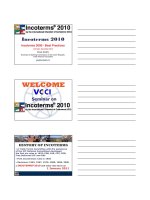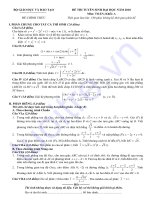PASSAGE 20(1)
Bạn đang xem bản rút gọn của tài liệu. Xem và tải ngay bản đầy đủ của tài liệu tại đây (77.91 KB, 5 trang )
PASSAGE 20
► Read the following passage and mark the letter A, B, C, or D on your answer sheet to
indicate the correct answer to each of the questions from I to 10.
PANDEMIC DISEASES
Diseases are a natural part of life on earth. If there were no diseases, the population
would grow too quickly, and there would not be enough food or other resources, so in a way,
diseases are natural ways of keeping the Earth in balance. But sometimes they spread very
quickly and kill large numbers of people. For example, in 1918, an outbreak of the flu spread
across the world, killing over 25 million people in only six months. Such terrible outbreaks of a
disease are called pandemics.
Pandemics happen when a disease changes in a way that our bodies are not prepared to fight.
In 1918, a new type of flu virus appeared. Our bodies had no way to fight this new flu virus, and
so it spread very quickly and killed large numbers of people. While there have been many
different pandemic diseases throughout history, all of them have a new thing in common.
First, all pandemic diseases spread from one person to another very easily.
Second, while they may kill many people, they generally do not kill people very quickly. A
good example of this would be the Marburg virus. The Marburg virus is an extremely infectious
disease. In addition, it is deadly. About 70 -80% of all people who get the Marburg virus died
from the disease. However, the Marburg virus has not become a pandemic because most people
die within three days of getting the disease. This means that the virus does not have enough time
to spread a large number of people. The flu virus of 1918, on the other hand, generally took about
a week to ten days to kill its victims, so it had more time to spread.
While we may never be able to completely stop pandemics, we can make them less
common. Doctors carefully monitor new diseases that they fear could become pandemics. For
example, in 2002, and 2003, doctors carefully watched SARS. Their health warnings may have
prevented SARS from becoming a pandemic.
Question 1: According to paragraph 1, how are diseases a natural part of life on Earth?
A.
They prevent pandemics
B.
They help control the population
C.
They led the world grow quickly
D.
They kill too many people
Question 2: Based on the information in the passage the term "pandemics''can be explained as
A.
diseases with no cure
B.
a deadly kind of flu
C.
diseases that spread quickly and kill large numbers of people
D.
new disease like SARS or the Marburg virus
Question 3: According to the passage, what causes pandemics?
– Website chuyên đề thi – tài liệu file word mới nhất
1
A.
Changes in a disease that body cannot fight
B.
Careless doctors who do not watch the spread of disease
C.
Population growth that the world cannot support
The failure to make new medicines
D.
Question 4: According to the passage, all of the following are true of the 1918 flu pandemic
EXCEPT that_________.
A.
it involved a new kind of flu virus
B.
it killed over 25 million people
C.
it was the last pandemic in history
D.
it took a little over a week to kill its victims
Question 5: The word "it" in the passage refers to______.
A. disease
B. fluvirus
C. pandemics
D. bodies
Question 6: Which of the following is mentioned as a common feature of all pandemic diseases?
They spread from people to people very quickly
A.
B.
It kill many people very quickly
C.
They do not kill people very quickly
They kill all the victims
D.
Question 7: According to paragraph 3, why hasn't Marburg virus become a pandemic?
A.
It is not a deadly disease
B.
It does not spread from person to person easily
C.
Doctors have prevented it from becoming a pandemic
D.
It kills people too quickly
Question 8: The word 'monitor' in the passage is closest in meaning to ____________.
A. fight
B. prevent
C. watch
D. avoid
Question 9: The author mentions SARS in order to____
A.
give an example of a highly dangerous disease
B.
suggest that SARS will never become a pandemic
C.
give an example of the successful prevention of a pandemic
D.
suggest that there may be a new pandemic soon.
Question 10: This passage is mainly about_____
A.
how to prevent pandemic diseases
B.
pandemic diseases
C.
pandemic diseases throughout history
D.
why pandemics happen
– Website chuyên đề thi – tài liệu file word mới nhất
2
ĐÁP ÁN
PASSAGE 20
Question 1: According to paragraph 1, how are diseases a natural part of life on Earth?
A.
Chúng ngăn chặn các đại dịch
B.
Chúng giúp kiểm soát dân sổ
C.
Chúng khiến cho thế giới phát triển nhanh hơn
D.
Chúng giết quá nhiều người
Diseases are a natural part of life on earth. If there were no diseases, the population would grow
too quickly, and there would not be enough food or other resources, so in a way, diseases are natural
ways of keeping the Earth in balance. (Nếu khơng có bệnh tật, dân sổ thế giới sẽ tăng trưởng rát
nhanh... bệnh tật là cách tự nhiên giữ cho Trái Đất trong tình trạng cân bằng)
=> B
Question 2:
Based on the information in the passage the term "pandemics" can be explained as
___________
But sometimes they spread very quickly and kill large numbers of people. For example, in
1918, an outbreak of the flu spread across the world, killing over 25 million people in only six
months. Such terrible outbreaks of a disease are called pandemics.
=> C
Question 3:
According to the passage, what causes pandemics?
Pandemics happen when a disease changes in a way that our bodies are not prepared to fight.
=> A
Question 4:
According to the passage, all of the following are true of the 1918 flu pandemic EXCEPT
that______.
Tất cả đều đúng về đại dịch cúm năm 1918 TRỪ:
A.
Nó tạo ra một chủng vi rút cúm mới
B.
Nó giết chết hơn 25 triệu người
C.
Nó là đại dịch cuối cùng trong lịch sử
D.
Nó mất hơn 1 tuần để giết chết các nạn nhân của căn bệnh
For example, in 1918, an outbreak of the flu spread across the world, killing over 25 million
people in only six months.
=> B đúng
– Website chuyên đề thi – tài liệu file word mới nhất
3
In 1918, a new type of flu virus appeared. => A đúng
Our bodies had no way to fight this new flu virus, and so it spread very quickly and killed large
numbers of people. While there have been many different pandemic diseases throughout history
=> C sai
Tho flu virus of 1918, on the other hand, generally took about a week to ten days to kill its
victims, so it had more time to spread. => D đúng
=> C
Question 5:
Our bodies had no way to fight this now flu virus, and so it spread very quickly and killed
large numbers of people
=> B
Question 6:
Which of the following is mentioned as a common feature of all pandemic diseases? (đặc
điểm chung của tắt cả các đại dịch)
First, all pandemic diseases spread from one person to another very easily.
Second, while they may kill many people, they generally do not kill people very quickly
=> C
Question 7:
According to paragraph 3, why hasn't Marburg virus become a pandemic?
However, the Marburg virus has not become a pandemic because most people die within three
days of getting the disease. This means that the virus does not have enough time to spread a large
number of people.
=> D
Questions 8:
- to monitor something: to watch and check something over a period of time in order to see how
it develops, so that you can make any necessary changes (theo từ điền Oxford Learner's Dictionary)
(theo dõi và kiểm tra cái gì trong suốt 1 khoảng thời gian để xem quá trình phát triển và tạo những
thay đổi cẩn thiết) .
=> C
Question 9:
The author mentions SARS in order to________.
A.đưa ra ví dụ về một loại bệnh vơ cùng nguy hiểm
B.gợi ý rằng SARS sẽ không bao giờ trở thành đại dịch
C.đưa ra ví dụ về sự phịng chống thành cơng một đại dịch
D.gợi ý rằng sẽ sớm có một đại dịch
For example, in 2002, and 2003, doctors carefully watched SARS. Their health warnings may
have prevented SARS from becoming a pandemic.
=> B
Question 10:
– Website chuyên đề thi – tài liệu file word mới nhất
4
Nội dung chính của bài viết
A.cách ngăn chặn các đại dịch
B.Các đại dịch
C.Các đại dịch trong suốt lịch sử
D.Tại sao các đại dịch xảy ra
=> B (bài viết nói vế các đại dịch bao gốm các ý lớn: đại dịch là gì, tại sao các đai dịch xảy ra,
cách phịng chống đại địch và liệt kê một số đại dịch trong lịch sử loài người)
Vocabulary
- pandemic (n): đại dịch
- in balance: ở trạng thái cân bằng
- outbreak (n): sự dùng phát (dịch bệnh)
- be in common (adj): trở nên phổ biển
- to spread from ... to ... (v): lây lan từ... sang...
- infectious (adj): lây nhiễm, có tính truyền nhiễm, lây lan
- victim (n): nạn nhân
- to monitor (v): xem xét và theo dõi
- prevent smt from doing smt: ngăn chặn cái gì làm gì
– Website chuyên đề thi – tài liệu file word mới nhất
5









